How to Lower Credit Card Interest Rates: 4 Options
A high-interest credit card can be a major burden on your finances. The average credit card interest rate was 14.75% as of February 2021, according to the Federal Reserve — which could translate into steep interest charges if you only pay the minimum payment each month.
However, there are ways to potentially lower your credit card interest rate, which could help you save money while paying off your balance.
Here’s how to lower credit card your interest rate:
Check your credit scoreCall your card issuer and askApply for a balance transfer cardTake out a personal loan
1. Check your credit score
Your credit score helps determine what kind of interest rates you qualify for. In general, the better your credit score, the lower your rate.
If you’d like to get a lower interest rate, you’ll likely need good to excellent credit — a good credit score is usually considered to be 700 or higher. This is why it’s a good idea to check your credit before making the request so you know where you stand.
Tip: You can use a site like AnnualCreditReport.com to review your credit reports for free. If you find any errors, dispute them with the appropriate credit bureaus to potentially boost your credit score.
Learn More: How Personal Loans Impact Your Credit Score
2. Call your card issuer and ask
One way to possibly get a lower credit card rate is to simply ask your credit card issuer for a reduction. Generally, credit card issuers are friendlier to these types of requests if you have good credit and are a good customer who pays your bills on time.
When you make the call, a few points to mention include:
How long you’ve been with the companyYour history of on-time paymentsWhether your credit score has gone upWhether you’ve received better offers from other credit card companiesTip: When you’re speaking to your customer service representative, respectfully explain the reason for your call (being nice and pleasant goes a long way!). Ask about lowering your interest rate and what steps you need to take in order to get that taken care of.
Also keep in mind that your request might not be approved. If this happens, don’t be discouraged — ask what you need to do to lower your interest rate and when you can request a reduced rate again in the future.
Check Out: How to Get Out of Credit Card Debt
3. Apply for a balance transfer card
A balance transfer card could be a good option if your current credit card company doesn’t approve you for a lower interest rate on your card. With a balance transfer card, you can move your balance from one card to another one with a lower rate.
Tip: Some balance transfer cards come with 0% APR introductory offers. This means you could avoid paying interest if you can repay your balance before this period ends. However, keep in mind that if you can’t pay off the card in time, you could get stuck with hefty interest charges.
Learn More: Personal Loan vs. Credit Card
4. Take out a personal loan
Another option is taking out a personal loan to pay off your credit card debt — a process known as debt consolidation. Personal loans often have lower credit card interest rates than credit cards, which means you could save money on interest charges while repaying your debt.
Tip: You’ll typically need good to excellent credit to get approved for a personal loan as well as to qualify for a low interest rate. While some lenders offer debt consolidation loans for bad credit, these personal loans often come with higher interest rates compared to good credit loans.
If you’re struggling to get approved, consider applying with a cosigner. Not all lenders allow cosigners on personal loans, but some do. Even if you don’t need a cosigner to qualify, having one could get you a lower interest rate than you’d get on your own.
If you decide to take out a personal loan, it’s important to think about how much that loan will cost you. This way, you can be prepared for any added expenses. You can estimate how much you’ll pay for a loan using our personal loan calculator below.
Enter your loan information to calculate how much you could pay
Loan amountEnter the total amount borrowedInterest rateEnter your annual interest rateorLoan termEnter the amount of time you have to repay your loanyears
Total Payment>
Total Interest>
Monthly Payment>
With a>
loan, you will pay>
monthly and a total of>
in interest over the life of your loan. You will pay a total of>
over the life of the
loan.
Need a personal loan?
Compare rates without affecting your credit score. 100% free!
Check Personalized Rates
Checking rates won’t affect your credit score.
Balance transfer card vs. personal loan
Balance transfer cards and personal loans are both options to consolidate credit card debt and hopefully save money on interest along the way. If you’re considering a balance transfer credit card vs. personal loan, here are a few pros and cons of each to keep in mind:
Pros of balance transfer credit cards
0% APR: Some balance transfer credit cards come with a 0% APR introductory offer, which means you can avoid paying interest if you pay off your balance before this period ends.Could help build your credit: If you make all of your payments on time, you might see your credit improve — which could help you qualify for better rates in the future.Rewards or perks: Depending on the card you choose, you might have access to various rewards or perks, such as cash back or points.
Check Out: How to Pay Off Credit Card Debt Fast
Cons of balance transfer credit cards
Balance transfer fees: Most cards charge a balance transfer fee — generally from 3% to 5% — that could increase your balance.Higher interest rates: Credit cards generally have higher interest rates than personal loans. While you might be able to take advantage of a 0% APR introductory offer — depending on the card — carrying a balance beyond this period could lead to steep interest charges if you don’t pay off the card by your due date each month.Might be tempting to rack up a balance: A balance transfer card is still a credit card. Even if you pay your initial balance off, it could be tempting to rack up a balance again.
Learn More: How Debt Consolidation Loans Can Help Your Credit Score
Pros of personal loans
Lower interest rates: Personal loan rates are usually lower compared to credit cards. This could save you money on interest charges and even help you pay off your loan faster.Fixed monthly payments: Personal loans generally have fixed interest rates, which means your monthly payments will stay the same throughout the life of the loan.Options for poor or fair credit: While many personal loan lenders require good to excellent credit, there are others that offer personal loans for bad credit.
Check Out: Small Personal Loans: Compare Top Lenders Today
Cons of personal loans
Might come with fees: Some lenders charge fees on personal loans, such as origination or late fees. This can add to your overall loan cost.Can have larger payments: Depending on your repayment terms, you might end up with higher monthly payments on a personal loan compared to a credit card. Before you sign for a loan, be sure your new payments will fit comfortably in your budget.No rewards: Unlike credit cards, personal loans don’t come with any rewards.
Learn More: How to Check If a Personal Loan Company Is Legitimate
How to take out a personal loan
If you decide to take out a personal loan to help reduce how much you pay in credit card interest, follow these four steps:
Check your credit. Like with credit cards, personal loan lenders will review your credit to determine your creditworthiness as well as what rates you qualify for. To see what shape your credit is in before you apply, use a site like AnnualCreditReport.com to review your credit reports for free. If you find any errors, dispute them with the appropriate credit bureaus to potentially boost your credit score.Compare lenders and pick a loan option. Be sure to consider as many lenders as possible to find the right loan for your needs. Consider not only interest rates but also repayment terms and any fees charged by the lender. After researching lenders, choose the loan option that works best for you.Complete the application. Once you’ve picked a personal loan lender, you’ll need to fill out a full application and submit any required documentation, such as tax returns or pay stubs.Get your funds. If you’re approved, the lender will have you sign for the loan so the money can be released to you. The time to fund for a personal loan is usually about one week — though some lenders will fund loans as soon as the same or next business day after approval. There are also lenders that will pay your creditors directly if you’d prefer.
Before you take out a personal loan, remember to consider as many lenders as you can to find the right loan for you. Credible makes this easy — you can compare your prequalified rates from our partner lenders in the table below in two minutes
LenderFixed ratesLoan amountsMin. credit scoreLoan terms (years)

Credible Rating>
Credible lender ratings are evaluated by our editorial team with the help of our loan operations team. The rating criteria for lenders encompass 78 data points spanning interest rates, loan terms, eligibility requirement transparency, repayment options, fees, discounts, customer service, cosigner options, and more. Read our full methodology.
View details>
9.95% – 35.99% APR$2,000 to $35,0005502, 3, 4, 5*Fixed APR:
9.95% – 35.99% APRVariable APR:
N/AMin. credit score:
550Loan amount:
$2,000 to $35,000**Loan terms (years):
2, 3, 4, 5*Time to fund:
As soon as the next business day (if approved by 4:30 p.m. CT on a weekday)Fees:
Origination feeDiscounts:
AutopayEligibility:
Available in all states except CO, IA, HI, VT, NV NY, WVCustomer service:
Phone, emailSoft credit check:
YesLoan servicer:
AvantLoan Uses:
Debt consolidation, emergency expense, life event, home improvement, and other purposesMin. Income:
$1,200 monthly

Credible Rating>
Credible lender ratings are evaluated by our editorial team with the help of our loan operations team. The rating criteria for lenders encompass 78 data points spanning interest rates, loan terms, eligibility requirement transparency, repayment options, fees, discounts, customer service, cosigner options, and more. Read our full methodology.
View details>
6.79% – 17.99% APR$5,000 to $35,0007401, 2, 3, 4, 5Fixed APR:
6.79% – 17.99% APRVariable APR:
N/AMin. credit score:
740Loan amount:
$5,000 to $35,000Loan terms (years):
1, 2, 3, 4, 5Time to fund:
Next business dayFees:
No prepayment penaltyDiscounts:
NoneEligibility:
Available in all 50 statesCustomer service:
PhoneSoft credit check:
YesMin. Income:
Does not discloseLoan Uses:
Debt consolidation, home improvement, self-employment, and other purposes
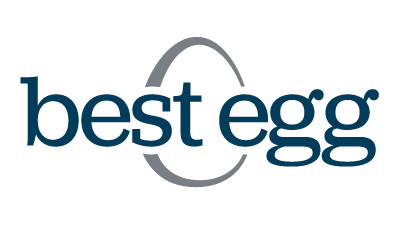
Credible Rating>
Credible lender ratings are evaluated by our editorial team with the help of our loan operations team. The rating criteria for lenders encompass 78 data points spanning interest rates, loan terms, eligibility requirement transparency, repayment options, fees, discounts, customer service, cosigner options, and more. Read our full methodology.
View details>
4.99% – 35.99% APR$5,000 to $35,0006002, 3, 4, 5Fixed APR:
4.99% – 35.99% APRVariable APR:
N/AMin. credit score:
600Loan amount:
$2,000 to $50,000Loan terms (years):
2, 3, 4, 5Time to fund:
As soon as 1 – 3 business days after successful verificationFees:
Origination feeDiscounts:
NoneEligibility:
Available in all states except DC, IA, VT, and WVCustomer service:
PhoneSoft credit check:
YesLoan servicer:
Best Egg and Blue Ridge BankMin. Income:
NoneLoan Uses:
Credit card refinancing, debt consolidation, home improvement, and other purposes
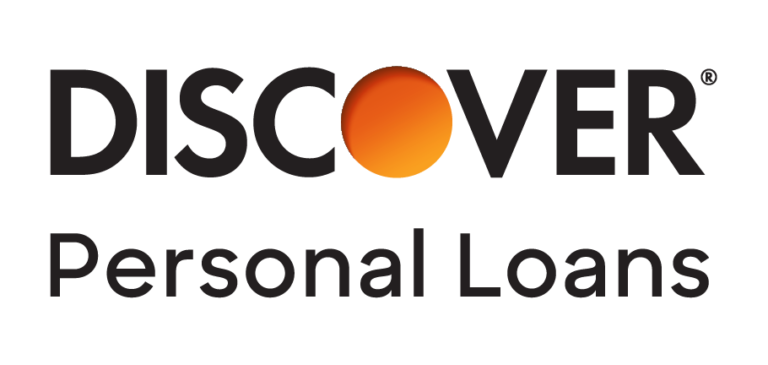
Credible Rating>
Credible lender ratings are evaluated by our editorial team with the help of our loan operations team. The rating criteria for lenders encompass 78 data points spanning interest rates, loan terms, eligibility requirement transparency, repayment options, fees, discounts, customer service, cosigner options, and more. Read our full methodology.
View details>
6.99% – 24.99% APR$2,500 to $35,0006603, 4, 5, 6, 7Fixed APR:
6.99% – 24.99% APRMin. credit score:
660Loan amount:
$2,500 to $35,000Loan terms (years):
3, 4, 5, 6, 7Time to fund:
As soon as the next business day after acceptanceFees:
Late feeDiscounts:
NoneEligibility:
Available in all 50 statesCustomer service:
PhoneSoft credit check:
YesLoan Uses:
Auto repair, credit card refinancing, debt consolidation, home remodel or repair, major purchase, medical expenses, taxes, vacation, and wedding

Credible Rating>
Credible lender ratings are evaluated by our editorial team with the help of our loan operations team. The rating criteria for lenders encompass 78 data points spanning interest rates, loan terms, eligibility requirement transparency, repayment options, fees, discounts, customer service, cosigner options, and more. Read our full methodology.
View details>
7.99% – 29.99% APR$10,000 to $50,000Not disclosed by lender2, 3, 4, 5Fixed APR:
7.99% – 29.99% APRMin. credit score:
Does not discloseLoan amount:
$10,000 to $50,000Loan terms (years):
2, 3, 4, 5Time to fund:
As soon as 2 business daysFees:
Origination feeDiscounts:
NoEligibility:
Available in all states except CO, CT, HI, KS, NH, NY, ND, OR, VT, WV, WI, and WYCustomer service:
PhoneSoft credit check:
YesMin. Income:
NoneLoan Uses:
Debt consolidation, home improvement, wedding, travel, medical expenses, and other purposes

Credible Rating>
Credible lender ratings are evaluated by our editorial team with the help of our loan operations team. The rating criteria for lenders encompass 78 data points spanning interest rates, loan terms, eligibility requirement transparency, repayment options, fees, discounts, customer service, cosigner options, and more. Read our full methodology.
View details>
7.04% – 35.89% APR$1,000 to $40,0006003, 5Fixed APR:
7.04% – 35.89% APRMin. credit score:
600Loan amount:
$1,000 to $40,000Loan terms (years):
3, 5Time to fund:
Usually takes about 2 daysFees:
Origination feeDiscounts:
NoneEligibility:
Available in all 50 statesCustomer service:
Phone, emailSoft credit check:
YesLoan servicer:
LendingClub BankMin. Income:
NoneLoan Uses:
Debt consolidation, paying off credit cards, home improvement, pool loans, vacations, and other purposes
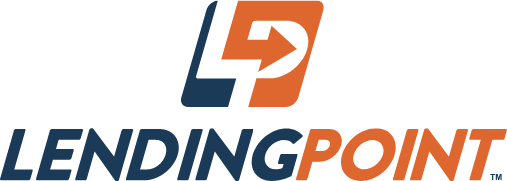
Credible Rating>
Credible lender ratings are evaluated by our editorial team with the help of our loan operations team. The rating criteria for lenders encompass 78 data points spanning interest rates, loan terms, eligibility requirement transparency, repayment options, fees, discounts, customer service, cosigner options, and more. Read our full methodology.
View details>
15.49% – 35.99% APR$2,000 to $36,5005802, 3, 4Fixed APR:
15.49% – 35.99% APRMin. credit score:
580Loan amount:
$2,000 to $36,500Loan terms (years):
2, 3, 4Time to fund:
As soon as the next business dayFees:
Origination feeDiscounts:
AutopayEligibility:
Available in all states except NV and WVCustomer service:
Phone, emailSoft credit check:
YesMin. Income:
$20,000Loan Uses:
Home improvement, consolidate debt, credit card refinancing, relocate, make a large purchase, and other purposes

Credible Rating>
Credible lender ratings are evaluated by our editorial team with the help of our loan operations team. The rating criteria for lenders encompass 78 data points spanning interest rates, loan terms, eligibility requirement transparency, repayment options, fees, discounts, customer service, cosigner options, and more. Read our full methodology.
View details>
2.49% – 19.99% APR$5,000 to $100,0006602, 3, 4, 5, 6, 7
(up to 12 years for home improvement loans)Fixed APR:
2.49% – 19.99% APRMin. credit score:
660Loan amount:
$5,000 to $100,000Loan terms (years):
2, 3, 4, 5, 6, 7*Time to fund:
As soon as the same business dayFees:
NoneDiscounts:
AutopayEligibility:
Available in all states except RI and VTCustomer service:
Phone, emailSoft credit check:
NoLoan servicer:
LightStreamMin. Income:
Does not discloseLoan Uses:
Credit card refinancing, debt consolidation, home improvement, and other purposes
Credible Rating>
Credible lender ratings are evaluated by our editorial team with the help of our loan operations team. The rating criteria for lenders encompass 78 data points spanning interest rates, loan terms, eligibility requirement transparency, repayment options, fees, discounts, customer service, cosigner options, and more. Read our full methodology.
View details>
6.99% – 19.99% APR1$3,500 to $40,0002660
(TransUnion FICO®️ Score 9)3, 4, 5, 6, 7Fixed APR:
6.99% – 19.99% APR1Min. credit score:
660
(TransUnion FICO®️ Score 9)Loan amount:
$3,500 to $40,0002Loan terms (years):
3, 4, 5, 6Time to fund:
Many Marcus customers receive funds in as little as three daysFees:
NoneDiscounts:
AutopayEligibility:
Available in all 50 statesCustomer service:
PhoneSoft credit check:
YesLoan servicer:
Goldman SachsMin. Income:
$30,000Loan Uses:
Credit card refinancing, debt consolidation, home improvement, major purchase, and other purposes
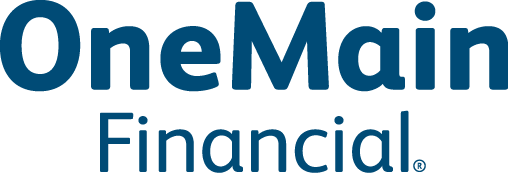
Credible Rating>
Credible lender ratings are evaluated by our editorial team with the help of our loan operations team. The rating criteria for lenders encompass 78 data points spanning interest rates, loan terms, eligibility requirement transparency, repayment options, fees, discounts, customer service, cosigner options, and more. Read our full methodology.
View details>
18.0% – 35.99% APR$1,500 to $20,000None2, 3, 4, 5Fixed APR:
18.0% – 35.99% APRMin. credit score:
NoneLoan amount:
$1,500 to $20,000Loan terms (years):
2, 3, 4, 5Time to fund:
As soon as the same day, but usually requires a visit to a branch officeFees:
Origination feeDiscounts:
NoneEligibility:
Must have photo I.D. issued by U.S. federal, state or local governmentCustomer service:
Phone, emailSoft credit check:
YesMin. Income:
Does not disclose

Credible Rating>
Credible lender ratings are evaluated by our editorial team with the help of our loan operations team. The rating criteria for lenders encompass 78 data points spanning interest rates, loan terms, eligibility requirement transparency, repayment options, fees, discounts, customer service, cosigner options, and more. Read our full methodology.
View details>
5.99% – 17.99% APR$600 to $50,000
(depending on loan term)6701, 2, 3, 4, 5Fixed APR:
5.99% – 17.99% APRMin. credit score:
670Loan amount:
$600 to $50,000*Loan terms (years):
1, 2, 3, 4, 5Time to fund:
2 to 4 business days after verificationFees:
NoneDiscounts:
NoneEligibility:
Does not discloseCustomer service:
Phone, emailSoft credit check:
NoMin. Income:
Does not discloseLoan Uses:
Debt consolidation, home improvement, transportation, medical, dental, life events

Credible Rating>
Credible lender ratings are evaluated by our editorial team with the help of our loan operations team. The rating criteria for lenders encompass 78 data points spanning interest rates, loan terms, eligibility requirement transparency, repayment options, fees, discounts, customer service, cosigner options, and more. Read our full methodology.
View details>
6.95% – 35.99% APR$2,000 to $40,0006403, 5Fixed APR:
6.95% – 35.99% APRMin. credit score:
640Loan amount:
$2,000 to $40,000Loan terms (years):
3, 5Time to fund:
As soon as one business dayFees:
Origination feeDiscounts:
NoneEligibility:
Available in all states except IA, ND, WVCustomer service:
Phone, emailSoft credit check:
YesMin. Income:
NoneLoan Uses:
Debt consolidation, home improvement, vehicles, small business, new baby expenses, and other purposes

Credible Rating>
Credible lender ratings are evaluated by our editorial team with the help of our loan operations team. The rating criteria for lenders encompass 78 data points spanning interest rates, loan terms, eligibility requirement transparency, repayment options, fees, discounts, customer service, cosigner options, and more. Read our full methodology.
View details>
5.99% – 18.83% APR$5,000 to $100,000Does not disclose2, 3, 4, 5, 6, 7Fixed APR:
5.99% – 18.83% APRMin. credit score:
Does not discloseLoan amount:
$5,000 to $100,000Loan terms (years):
2, 3, 4, 5, 6, 7Time to fund:
3 business daysFees:
NoneDiscounts:
AutopayEligibility:
Available in all states except MSCustomer service:
Phone, emailSoft credit check:
YesMin. Income:
Does not discloseLoan Uses:
Solely for personal, family, or household uses

Credible Rating>
Credible lender ratings are evaluated by our editorial team with the help of our loan operations team. The rating criteria for lenders encompass 78 data points spanning interest rates, loan terms, eligibility requirement transparency, repayment options, fees, discounts, customer service, cosigner options, and more. Read our full methodology.
View details>
8.93% – 35.93% APR7$1,000 to $50,0005603 to 5 years 8Fixed APR:
8.93% – 35.93% APR7Min. credit score:
560Loan amount:
$1,000 to $50,000Loan terms:
3 to 5 years 8Time to fund:
Within one day, once approved9Loan types:
Debt consolidation, pay off credit cards, home improvements, unexpected expenses, home and auto repairs, weddings, and other major purchasesFees:
Origination feeDiscounts:
AutopayEligibility:
A U.S. citizen or permanent resident; not available in DC, SC, WVCustomer service:
Phone, emailSoft credit check:
Yes

Credible Rating>
Credible lender ratings are evaluated by our editorial team with the help of our loan operations team. The rating criteria for lenders encompass 78 data points spanning interest rates, loan terms, eligibility requirement transparency, repayment options, fees, discounts, customer service, cosigner options, and more. Read our full methodology.
View details>
5.94% – 35.97% APR$1,000 to $50,0005602, 3, 5, 6Fixed APR:
5.94% – 35.97% APRMin. credit score:
560Loan amount:
$1,000 to $50,000*Loan terms (years):
2, 3, 5, 6Time to fund:
Within a day of clearing necessary verificationsFees:
Origination feeDiscounts:
AutopayEligibility:
Available in all states except West VirginiaCustomer service:
EmailSoft credit check:
YesMin. Income:
Does not discloseLoan Uses:
Debt consolidation, credit card refinancing, home improvement, and other purposes

Credible Rating>
Credible lender ratings are evaluated by our editorial team with the help of our loan operations team. The rating criteria for lenders encompass 78 data points spanning interest rates, loan terms, eligibility requirement transparency, repayment options, fees, discounts, customer service, cosigner options, and more. Read our full methodology.
View details>
6.46% – 35.99% APR4$1,000 to $50,00055803 to 5 years4Fixed APR:
6.46% – 35.99% APR4Min. credit score:
580Loan amount:
$1,000 to $50,0005Loan terms (years):
3 to 5 years4Time to fund:
As fast as 1 business day6Fees:
Origination feeDiscounts:
NoneEligibility:
Available in all 50 statesCustomer service:
Phone, emailSoft credit check:
YesMin. Income:
$12,000Loan Uses:
Payoff credit cards, consolidate debt, take a course or bootcamp, relocate, make a large purchase, and other purposesCompare rates from these lenders without affecting your credit score. 100% free!
Compare Now
Trustpilot
All APRs reflect autopay and loyalty discounts where available | LightStream disclosure | Read more about Rates and Terms
Should you close your credit card?
After you’ve paid off a credit card, you might consider closing it. However, keep in mind that if you close a credit card account, you might see your credit score drop. This is because a closed account could:
Raise your credit utilization ratio, as you might have less available credit compared to how much you oweLower the average age of your credit accounts, especially if you’ve had the account for an extended period of time
However, if you continue making payments on time on your other credit accounts, your score will likely bounce back within a few months.
Tip: Ultimately, whether to close an account depends on your individual circumstances. For example, if you feel that keeping a credit card account open could lead you into more debt, then it might be better to close the account and deal with the potential credit score changes.
Keep Reading: Pay Off Credit Card Debt ASAP With a Personal Loan
About Rates and Terms: Rates for personal loans provided by lenders on the Credible platform range between 4.99-35.99% APR with terms from 12 to 84 months. Rates presented include lender discounts for enrolling in autopay and loyalty programs, where applicable. Actual rates may be different from the rates advertised and/or shown and will be based on the lender’s eligibility criteria, which include factors such as credit score, loan amount, loan term, credit usage and history, and vary based on loan purpose. The lowest rates available typically require excellent credit, and for some lenders, may be reserved for specific loan purposes and/or shorter loan terms. The origination fee charged by the lenders on our platform ranges from 0% to 8%. Each lender has their own qualification criteria with respect to their autopay and loyalty discounts (e.g., some lenders require the borrower to elect autopay prior to loan funding in order to qualify for the autopay discount). All rates are determined by the lender and must be agreed upon between the borrower and the borrower’s chosen lender. For a loan of $10,000 with a three year repayment period, an interest rate of 7.99%, a $350 origination fee and an APR of 11.51%, the borrower will receive $9,650 at the time of loan funding and will make 36 monthly payments of $313.32. Assuming all on-time payments, and full performance of all terms and conditions of the loan contract and any discount programs enrolled in included in the APR/interest rate throughout the life of the loan, the borrower will pay a total of $11,279.43. As of March 12, 2019, none of the lenders on our platform require a down payment nor do they charge any prepayment penalties.
The post How to Lower Credit Card Interest Rates: 4 Options appeared first on Credible.
How to Pay Off $10,000 in Credit Card Debt
Facing a large amount of credit card debt can feel overwhelming, especially since it might take a while to pay off. If you have $10,000 in credit card debt, it could take over a decade to repay if you make only minimum payments.
However, there are a few strategies that could make it easier to pay off $10,000 in credit card debt.
Here are four ways to pay off $10,000 in credit card debt:
Consolidate your debtWork with your credit card companyChoose a debt payoff strategyReevaluate your current spending
1. Consolidate your debt
Depending on your credit, consolidating your credit card debt might get you a lower interest rate — this could save you money on interest as well as potentially help you pay off your debt more quickly.
Here are a few options for consolidating credit card debt:
Take out a credit card consolidation loan
Best if: You have multiple high-interest credit cards to consolidate.
A credit card consolidation loan is a type of personal loan specifically used to consolidate credit card debt. If you have good to excellent credit, you might qualify for a lower interest rate than what you’re currently paying — this could save you hundreds or even thousands of dollars on interest charges.
Or you could opt to extend your repayment term to lower your monthly payments and lessen the strain on your budget. Just keep in mind that choosing a longer term means you’ll pay more in interest over time.
For example, here’s how much someone might save by consolidating their credit card debt with a personal loan:
Pros
Fixed rates: Personal loan rates are fixed, which means your payments will stay the same throughout the life of the loan. Additionally, personal loans usually have lower interest rates compared to credit cards.Could get a lower interest rate: If you have good credit, you might get a lower interest rate with a credit card consolidation loan.Fast loan process: Many personal loan lenders provide a quick and easy application process. If you’re approved, you’ll generally have your funds within a week — though some lenders will fund loans as soon as the same or next business day after approval.
Cons
Fewer options for poor or fair credit: You’ll typically need good to excellent credit to qualify for a personal loan — especially if you want to get a lower interest rate. There are also several lenders that offer personal loans for bad credit, but these loans usually come with higher interest rates compared to good credit loans.Might come with fees: Some lenders charge fees on personal loans, such as origination or late fees.No perks or rewards: Personal loans don’t offer the perks and rewards that sometimes come with credit cards.Tip: If you have bad credit and are struggling to get approved for a personal loan, consider applying with a creditworthy cosigner to improve your chances. Not all lenders allow cosigners on personal loans, but some do.
Even if you don’t need a cosigner to qualify, having one might get you a lower interest rate than you’d get on your own.
If you decide to take out a personal loan to consolidate credit card debt, be sure to consider as many lenders as possible to find the right loan for your needs.
Credible makes this easy — you can compare your prequalified rates from our partner lenders in the table below in two minutes.
LenderFixed ratesLoan amountsMin. credit scoreLoan terms (years)

Credible Rating>
Credible lender ratings are evaluated by our editorial team with the help of our loan operations team. The rating criteria for lenders encompass 78 data points spanning interest rates, loan terms, eligibility requirement transparency, repayment options, fees, discounts, customer service, cosigner options, and more. Read our full methodology.
View details>
9.95% – 35.99% APR$2,000 to $35,0005502, 3, 4, 5*Fixed APR:
9.95% – 35.99% APRVariable APR:
N/AMin. credit score:
550Loan amount:
$2,000 to $35,000**Loan terms (years):
2, 3, 4, 5*Time to fund:
As soon as the next business day (if approved by 4:30 p.m. CT on a weekday)Fees:
Origination feeDiscounts:
AutopayEligibility:
Available in all states except CO, IA, HI, VT, NV NY, WVCustomer service:
Phone, emailSoft credit check:
YesLoan servicer:
AvantLoan Uses:
Debt consolidation, emergency expense, life event, home improvement, and other purposesMin. Income:
$1,200 monthly

Credible Rating>
Credible lender ratings are evaluated by our editorial team with the help of our loan operations team. The rating criteria for lenders encompass 78 data points spanning interest rates, loan terms, eligibility requirement transparency, repayment options, fees, discounts, customer service, cosigner options, and more. Read our full methodology.
View details>
6.79% – 17.99% APR$5,000 to $35,0007401, 2, 3, 4, 5Fixed APR:
6.79% – 17.99% APRVariable APR:
N/AMin. credit score:
740Loan amount:
$5,000 to $35,000Loan terms (years):
1, 2, 3, 4, 5Time to fund:
Next business dayFees:
No prepayment penaltyDiscounts:
NoneEligibility:
Available in all 50 statesCustomer service:
PhoneSoft credit check:
YesMin. Income:
Does not discloseLoan Uses:
Debt consolidation, home improvement, self-employment, and other purposes
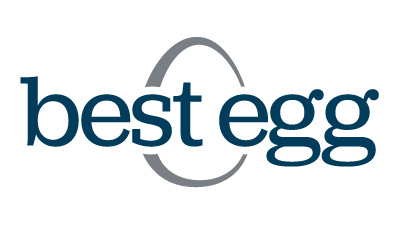
Credible Rating>
Credible lender ratings are evaluated by our editorial team with the help of our loan operations team. The rating criteria for lenders encompass 78 data points spanning interest rates, loan terms, eligibility requirement transparency, repayment options, fees, discounts, customer service, cosigner options, and more. Read our full methodology.
View details>
4.99% – 35.99% APR$2,000 to $50,0006003, 5Fixed APR:
4.99% – 35.99% APRVariable APR:
N/AMin. credit score:
600Loan amount:
$2,000 to $50,000Loan terms (years):
2, 3, 4, 5Time to fund:
As soon as 1 – 3 business days after successful verificationFees:
Origination feeDiscounts:
NoneEligibility:
Available in all states except DC, IA, VT, and WVCustomer service:
PhoneSoft credit check:
YesLoan servicer:
Best Egg and Blue Ridge BankMin. Income:
NoneLoan Uses:
Credit card refinancing, debt consolidation, home improvement, and other purposes
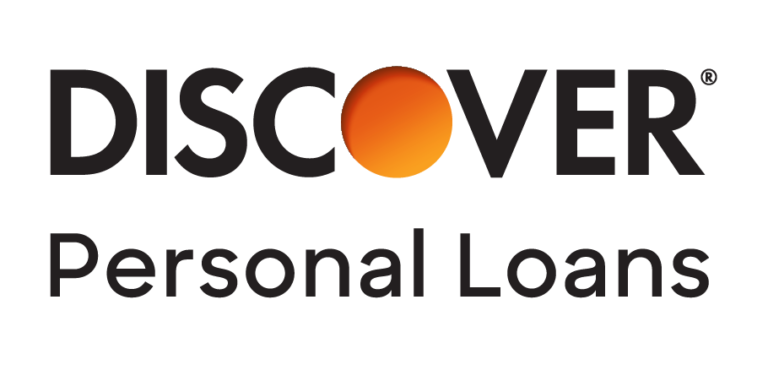
Credible Rating>
Credible lender ratings are evaluated by our editorial team with the help of our loan operations team. The rating criteria for lenders encompass 78 data points spanning interest rates, loan terms, eligibility requirement transparency, repayment options, fees, discounts, customer service, cosigner options, and more. Read our full methodology.
View details>
6.99% – 24.99% APR$2,500 to $35,0006603, 4, 5, 6, 7Fixed APR:
6.99% – 24.99% APRMin. credit score:
660Loan amount:
$2,500 to $35,000Loan terms (years):
3, 4, 5, 6, 7Time to fund:
As soon as the next business day after acceptanceFees:
Late feeDiscounts:
NoneEligibility:
Available in all 50 statesCustomer service:
PhoneSoft credit check:
YesLoan Uses:
Auto repair, credit card refinancing, debt consolidation, home remodel or repair, major purchase, medical expenses, taxes, vacation, and wedding

Credible Rating>
Credible lender ratings are evaluated by our editorial team with the help of our loan operations team. The rating criteria for lenders encompass 78 data points spanning interest rates, loan terms, eligibility requirement transparency, repayment options, fees, discounts, customer service, cosigner options, and more. Read our full methodology.
View details>
7.99% – 29.99% APR$10,000 to $35,000Not disclosed by lender2, 3, 4, 5Fixed APR:
7.99% – 29.99% APRMin. credit score:
Does not discloseLoan amount:
$10,000 to $50,000Loan terms (years):
2, 3, 4, 5Time to fund:
As soon as 2 business daysFees:
Origination feeDiscounts:
NoEligibility:
Available in all states except CO, CT, HI, KS, NH, NY, ND, OR, VT, WV, WI, and WYCustomer service:
PhoneSoft credit check:
YesMin. Income:
NoneLoan Uses:
Debt consolidation, home improvement, wedding, travel, medical expenses, and other purposes

Credible Rating>
Credible lender ratings are evaluated by our editorial team with the help of our loan operations team. The rating criteria for lenders encompass 78 data points spanning interest rates, loan terms, eligibility requirement transparency, repayment options, fees, discounts, customer service, cosigner options, and more. Read our full methodology.
View details>
7.04% – 35.89% APR$1,000 to $40,0006003, 5Fixed APR:
7.04% – 35.89% APRMin. credit score:
600Loan amount:
$1,000 to $40,000Loan terms (years):
3, 5Time to fund:
Usually takes about 2 daysFees:
Origination feeDiscounts:
NoneEligibility:
Available in all 50 statesCustomer service:
Phone, emailSoft credit check:
YesLoan servicer:
LendingClub BankMin. Income:
NoneLoan Uses:
Debt consolidation, paying off credit cards, home improvement, pool loans, vacations, and other purposes
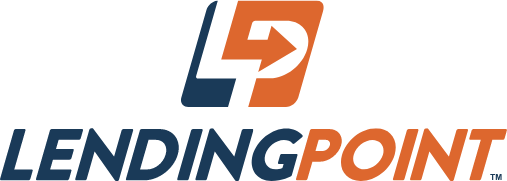
Credible Rating>
Credible lender ratings are evaluated by our editorial team with the help of our loan operations team. The rating criteria for lenders encompass 78 data points spanning interest rates, loan terms, eligibility requirement transparency, repayment options, fees, discounts, customer service, cosigner options, and more. Read our full methodology.
View details>
15.49% – 35.99% APR$2,000 to $36,5005802, 3, 4Fixed APR:
15.49% – 35.99% APRMin. credit score:
580Loan amount:
$2,000 to $36,500Loan terms (years):
2, 3, 4Time to fund:
As soon as the next business dayFees:
Origination feeDiscounts:
AutopayEligibility:
Available in all states except NV and WVCustomer service:
Phone, emailSoft credit check:
YesMin. Income:
$20,000Loan Uses:
Home improvement, consolidate debt, credit card refinancing, relocate, make a large purchase, and other purposes

Credible Rating>
Credible lender ratings are evaluated by our editorial team with the help of our loan operations team. The rating criteria for lenders encompass 78 data points spanning interest rates, loan terms, eligibility requirement transparency, repayment options, fees, discounts, customer service, cosigner options, and more. Read our full methodology.
View details>
2.49% – 19.99% APR$5,000 to $100,0006602, 3, 4, 5, 6, 7
(up to 12 years for home improvement loans)Fixed APR:
2.49% – 19.99% APRMin. credit score:
660Loan amount:
$5,000 to $100,000Loan terms (years):
2, 3, 4, 5, 6, 7*Time to fund:
As soon as the same business dayFees:
NoneDiscounts:
AutopayEligibility:
Available in all states except RI and VTCustomer service:
Phone, emailSoft credit check:
NoLoan servicer:
LightStreamMin. Income:
Does not discloseLoan Uses:
Credit card refinancing, debt consolidation, home improvement, and other purposes
Credible Rating>
Credible lender ratings are evaluated by our editorial team with the help of our loan operations team. The rating criteria for lenders encompass 78 data points spanning interest rates, loan terms, eligibility requirement transparency, repayment options, fees, discounts, customer service, cosigner options, and more. Read our full methodology.
View details>
6.99% – 19.99% APR1$3,500 to $40,0002660
(TransUnion FICO®️ Score 9)3, 4, 5, 6, 7Fixed APR:
6.99% – 19.99% APR1Min. credit score:
660
(TransUnion FICO®️ Score 9)Loan amount:
$3,500 to $40,0002Loan terms (years):
3, 4, 5, 6Time to fund:
Many Marcus customers receive funds in as little as three daysFees:
NoneDiscounts:
AutopayEligibility:
Available in all 50 statesCustomer service:
PhoneSoft credit check:
YesLoan servicer:
Goldman SachsMin. Income:
$30,000Loan Uses:
Credit card refinancing, debt consolidation, home improvement, major purchase, and other purposes
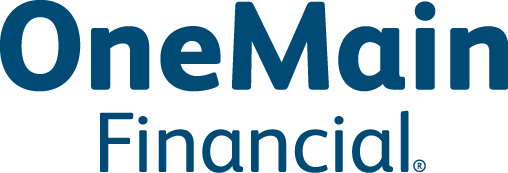
Credible Rating>
Credible lender ratings are evaluated by our editorial team with the help of our loan operations team. The rating criteria for lenders encompass 78 data points spanning interest rates, loan terms, eligibility requirement transparency, repayment options, fees, discounts, customer service, cosigner options, and more. Read our full methodology.
View details>
18.0% – 35.99% APR$1,500 to $20,000None2, 3, 4, 5Fixed APR:
18.0% – 35.99% APRMin. credit score:
NoneLoan amount:
$1,500 to $20,000Loan terms (years):
2, 3, 4, 5Time to fund:
As soon as the same day, but usually requires a visit to a branch officeFees:
Origination feeDiscounts:
NoneEligibility:
Must have photo I.D. issued by U.S. federal, state or local governmentCustomer service:
Phone, emailSoft credit check:
YesMin. Income:
Does not disclose

Credible Rating>
Credible lender ratings are evaluated by our editorial team with the help of our loan operations team. The rating criteria for lenders encompass 78 data points spanning interest rates, loan terms, eligibility requirement transparency, repayment options, fees, discounts, customer service, cosigner options, and more. Read our full methodology.
View details>
5.99% – 24.99% APR$5,000 to $40,0006002, 3, 4, 5Fixed APR:
5.99% – 24.99% APRMin. credit score:
600Loan amount:
$5,000 to $40,000Loan terms (years):
2, 3, 4, 5Time to fund:
As soon as 2 – 5 business days after verificationFees:
Origination feeDiscounts:
NoneEligibility:
Available in all states except MA, NV, and OHCustomer service:
Phone, email, chatSoft credit check:
YesMin. Income:
NoneLoan Uses:
Debt consolidation and credit card consolidation only

Credible Rating>
Credible lender ratings are evaluated by our editorial team with the help of our loan operations team. The rating criteria for lenders encompass 78 data points spanning interest rates, loan terms, eligibility requirement transparency, repayment options, fees, discounts, customer service, cosigner options, and more. Read our full methodology.
View details>
5.99% – 17.99% APR$600 to $50,000
(depending on loan term)6701, 2, 3, 4, 5Fixed APR:
5.99% – 17.99% APRMin. credit score:
670Loan amount:
$600 to $50,000*Loan terms (years):
1, 2, 3, 4, 5Time to fund:
2 to 4 business days after verificationFees:
NoneDiscounts:
NoneEligibility:
Does not discloseCustomer service:
Phone, emailSoft credit check:
NoMin. Income:
Does not discloseLoan Uses:
Debt consolidation, home improvement, transportation, medical, dental, life events

Credible Rating>
Credible lender ratings are evaluated by our editorial team with the help of our loan operations team. The rating criteria for lenders encompass 78 data points spanning interest rates, loan terms, eligibility requirement transparency, repayment options, fees, discounts, customer service, cosigner options, and more. Read our full methodology.
View details>
6.95% – 35.99% APR$2,000 to $40,0006403, 5Fixed APR:
6.95% – 35.99% APRMin. credit score:
640Loan amount:
$2,000 to $40,000Loan terms (years):
3, 5Time to fund:
As soon as one business dayFees:
Origination feeDiscounts:
NoneEligibility:
Available in all states except IA, ND, WVCustomer service:
Phone, emailSoft credit check:
YesMin. Income:
NoneLoan Uses:
Debt consolidation, home improvement, vehicles, small business, new baby expenses, and other purposes

Credible Rating>
Credible lender ratings are evaluated by our editorial team with the help of our loan operations team. The rating criteria for lenders encompass 78 data points spanning interest rates, loan terms, eligibility requirement transparency, repayment options, fees, discounts, customer service, cosigner options, and more. Read our full methodology.
View details>
5.99% – 18.83% APR$5,000 to $100,000Does not disclose2, 3, 4, 5, 6, 7Fixed APR:
5.99% – 18.83% APRMin. credit score:
Does not discloseLoan amount:
$5,000 to $100,000Loan terms (years):
2, 3, 4, 5, 6, 7Time to fund:
3 business daysFees:
NoneDiscounts:
AutopayEligibility:
Available in all states except MSCustomer service:
Phone, emailSoft credit check:
YesMin. Income:
Does not discloseLoan Uses:
Solely for personal, family, or household uses

Credible Rating>
Credible lender ratings are evaluated by our editorial team with the help of our loan operations team. The rating criteria for lenders encompass 78 data points spanning interest rates, loan terms, eligibility requirement transparency, repayment options, fees, discounts, customer service, cosigner options, and more. Read our full methodology.
View details>
8.93% – 35.93% APR7$1,000 to $20,0005603, 5Fixed APR:
8.93% – 35.93% APR7Min. credit score:
560Loan amount:
$1,000 to $50,000Loan terms:
3 to 5 years 8Time to fund:
Within one day, once approved9Loan types:
Debt consolidation, pay off credit cards, home improvements, unexpected expenses, home and auto repairs, weddings, and other major purchasesFees:
Origination feeDiscounts:
AutopayEligibility:
A U.S. citizen or permanent resident; not available in DC, SC, WVCustomer service:
Phone, emailSoft credit check:
Yes

Credible Rating>
Credible lender ratings are evaluated by our editorial team with the help of our loan operations team. The rating criteria for lenders encompass 78 data points spanning interest rates, loan terms, eligibility requirement transparency, repayment options, fees, discounts, customer service, cosigner options, and more. Read our full methodology.
View details>
5.94% – 35.97% APR$1,000 to $50,0005602, 3, 5, 6Fixed APR:
5.94% – 35.97% APRMin. credit score:
560Loan amount:
$1,000 to $50,000*Loan terms (years):
2, 3, 5, 6Time to fund:
Within a day of clearing necessary verificationsFees:
Origination feeDiscounts:
AutopayEligibility:
Available in all states except West VirginiaCustomer service:
EmailSoft credit check:
YesMin. Income:
Does not discloseLoan Uses:
Debt consolidation, credit card refinancing, home improvement, and other purposes

Credible Rating>
Credible lender ratings are evaluated by our editorial team with the help of our loan operations team. The rating criteria for lenders encompass 78 data points spanning interest rates, loan terms, eligibility requirement transparency, repayment options, fees, discounts, customer service, cosigner options, and more. Read our full methodology.
View details>
6.46% – 35.99% APR4$1,000 to $50,00055803 to 5 years4Fixed APR:
6.46% – 35.99% APR4Min. credit score:
580Loan amount:
$1,000 to $50,0005Loan terms (years):
3 to 5 years4Time to fund:
As fast as 1 business day6Fees:
Origination feeDiscounts:
NoneEligibility:
Available in all 50 statesCustomer service:
Phone, emailSoft credit check:
YesMin. Income:
$12,000Loan Uses:
Payoff credit cards, consolidate debt, take a course or bootcamp, relocate, make a large purchase, and other purposesCompare rates from these lenders without affecting your credit score. 100% free!
Compare Now
Trustpilot
All APRs reflect autopay and loyalty discounts where available | LightStream disclosure | Read more about Rates and Terms
Use a balance transfer card
Best if: You plan to pay off your balance quickly.
Another option for consolidating credit card debt is a balance transfer. This process lets you move your balance from one credit card to another.
Some balance transfer cards come with a 0% APR introductory offer, which means you could avoid paying interest if you can repay your debt before this period ends — usually within nine to 21 months, depending on the card.
However, if you can’t pay off your debt in time, you could stick with some hefty interest charges.
Pros
0% APR offer: Depending on the card you choose, you might be able to take advantage of a 0% APR introductory period and avoid paying interest for a certain period of time. This could be especially helpful if you plan to repay your balance quickly.Could help establish credit history: If you keep the balance transfer card open after paying off your initial debt, you can continue to use it to build your positive payment history and improve your credit.Might offer rewards or other perks: Some balance transfer cards provide various rewards or perks, such as cash back or travel points.
Cons
Might come with fees: In many cases, you’ll have to pay a balance transfer fee. This can range from 3% to 5% of the balance you want to transfer.Could come with high interest charges: If you don’t choose a card with a 0% APR introductory offer or can’t pay off your balance before this period ends, you could end up paying a large amount of interest.Might lead to further debt: Although a balance transfer card could help you manage your debt, it’s still another credit card — for some borrowers, it might be tempting to rack up a balance again.
Learn More: Refinancing Credit Card Debt and Getting Approved: Guide
Tap into your home’s equity
Best if: You own a home with at least 15% to 20% equity.
If you’re a homeowner, you might be able to tap into your home’s equity with a home equity loan or home equity line of credit (HELOC) and use the funds to consolidate your credit card debt.
With a home equity loan, you’ll get a lump sum that you can use how you wish.With a HELOC, you’ll have access to a revolving credit line that you can repeatedly draw on and pay off.
Because these loans are secured by your home, they often come with lower interest rates compared to credit cards or personal loans.
However, keep in mind that if you can’t keep up with your payments, you risk losing your house.
Pros
Lower interest rates: Because there’s less risk to the lender, home equity loans and HELOCs tend to have lower interest rates than credit cards or personal loans.Long repayment term: You could have five to 30 years to repay a home equity loan or up to 20 years to pay off a HELOC.Can use funds for any purpose: You can use the funds from a home equity loan or HELOC for almost any purpose. This could be helpful if you have other expenses to cover in addition to your credit card debt.
Cons
Risk of foreclosure: If you can’t make your payments on a home equity loan or HELOC, the lender could seize your home.Closing costs: Home equity loans and HELOCs can come with similar closing costs as a traditional mortgage — often 2% to 5%.Longer process: Depending on the complexity of the loan, it could take a few weeks for your loan to be processed and funded.
Check Out: Home Equity Loan vs. Personal Loan: Which Is Right for You?
2. Work with your credit card company
In some cases, you might be able to work out an arrangement with your credit card company that could help you tackle your debt. Here are a few options to consider:
sk your credit card company about a hardship plan
Best if: Your account is in good standing.
If your credit card payments are becoming too difficult to manage, it’s a good idea to call your card company to see if any assistance is available to you.
For example, several credit card companies offer hardship plans, which often provide a lower interest rate, reduced monthly payments, and lower fees.
Generally, credit card companies prefer to work with long-time customers who haven’t missed any payments. If you think you might not be able to make a payment, be sure to reach out to your card issuer as soon as possible.
Pros
Could lower your interest rate: A hardship plan could temporarily provide more optimal terms, such as a lower interest rate.Fixed repayment: Hardship plans usually come with fixed repayment schedules, which could make it easier to budget for your payments.Maintain good standing: If you reach out to your credit card company before you miss any payments, you’ll have a better chance of keeping your account in good standing with the company.
Cons
Might hurt your credit: Your card issuer might suspend or close your account for the duration of the hardship plan, which could lead to a decrease in your credit score.Could make it hard to access more credit: If your card issuer reports your hardship plan to the credit bureaus, you might have a harder time qualifying for other loans and credit in the future.Can’t combine multiple cards: If you have debt on multiple credit cards and want to sign up for a hardship plan, you’ll need to contact each card issuer individually.
Learn More: Coronavirus Hardship Loans: 7 Options to Consider
Try to negotiate a debt settlement
Best if: You have a sum of cash that you can use to negotiate a settlement for less than what you owe.
Debt settlement is an arrangement where your credit card company agrees to accept a lump sum or number of payments for less than what you owe in order to settle the account.
You can approach your creditor to discuss settlement on your own, or you could involve one of the several for-profit companies that offer debt settlement services.
Keep in mind: For-profit debt settlement companies often ask you to stop making payments on your accounts while they negotiate with your creditors, which could severely damage your credit.
Pros
Might be able to pay off your debt for less than what you owe: If your card issuer accepts the debt settlement plan, you could pay off your debt for less than what you actually owe.Can be done on your own: While there are several companies that could help you pursue debt settlement, you also have the option to work with your card issuer on your own.Could help you avoid bankruptcy: If you don’t want to file for bankruptcy, debt settlement might be a helpful option.
Cons
Could damage your credit: Your credit report will reflect that you settled an account for less than what you owed, which could hurt your credit. Your credit could also be damaged if you work with a for-profit company and agree to stop making payments.Potential fees: Debt settlement companies usually charge a fee for their services ranging from 20% to 25% of your final settlement amount.Might not work: There’s no guarantee that your card issuer will accept the settlement offer.
Check Out: How to Get Out of Credit Card Debt
Consider a debt management plan
Best if: You want professional guidance on the best way to repay your debt.
If you’re not sure how to tackle your debt, signing up for a debt management plan might be a good idea. With this option, a nonprofit debt counseling agency — such as the National Foundation for Credit Counseling — will help you come to an agreement with your creditors.
Debt management plans typically last for three to five years until your debt is paid off. During this time, you’ll make your payments to the agency, which will send the agreed-upon amounts to your creditors.
Pros
Professional help to manage your debt: Credit counselors offer a variety of resources and educational tools to help you take control of your debt and create good credit habits.Might come with lower interest rate and fees: Your creditors might agree to lower your interest rates and reduce or waive fees if you sign up for a debt management plan.Could improve your credit score: Making on-time payments under a debt management plan could help you build a positive payment history and improve your credit score over time.
Cons
Might close your credit cards: Any credit cards included in a debt management plan will likely have to be closed, meaning you’ll have less access to credit. Additionally, you might not be permitted to apply for new credit for the duration of the plan.Could come with fees: Depending on the agency you choose, you might have to pay upfront and monthly fees.Will have to pay off your debt in full: Unlike with a debt settlement, you’ll have to pay off your full balance on a debt management plan.Tip: Under a debt management plan, you’ll make just one monthly payment — similar to debt consolidation. However, you won’t necessarily be able to get a lower interest rate.
If you have good credit and can qualify for a lower interest rate on a personal loan, consolidating your debt might be a better option if you’re looking to save money on your debt.
Just remember to consider how much a personal loan will cost you before you borrow so you can be prepared for any added expenses.
You can estimate how much you’ll pay for a loan using our personal loan calculator below.
Enter your loan information to calculate how much you could pay
Loan amountEnter the total amount borrowedInterest rateEnter your annual interest rateorLoan termEnter the amount of time you have to repay your loanyears
Total Payment>
Total Interest>
Monthly Payment>
With a>
loan, you will pay>
monthly and a total of>
in interest over the life of your loan. You will pay a total of>
over the life of the
loan.
Need a personal loan?
Compare rates without affecting your credit score. 100% free!
Check Personalized Rates
Checking rates won’t affect your credit score.
3. Choose a debt payoff strategy
If you have multiple cards to pay off, choosing a debt payoff strategy could be helpful. Here are a couple of methods to consider:
Use the debt avalanche method
Best if: You’re motivated by long-term interest savings.
With the debt avalanche method, you’ll focus on paying off your debt with the highest interest rate first.
Here’s how it works:
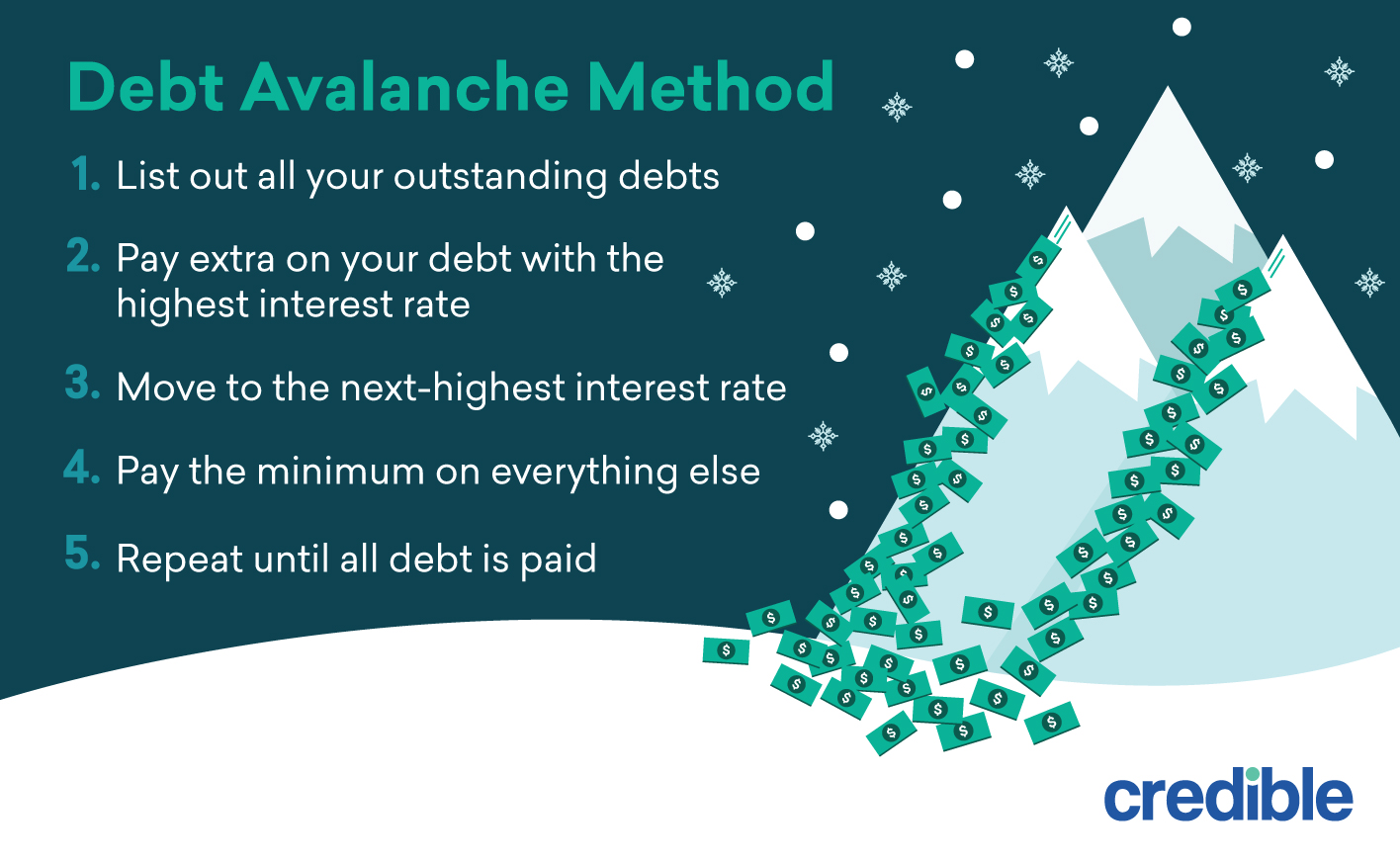
Pros
Could save money on interest: Paying down your highest-interest debt first could help you reduce your overall interest charges.Might get out of debt faster: Saving money on interest might help you pay off your debt ahead of schedule.
Cons
Could take longer to see results: While paying down your highest-interest debt might help you save money on interest, it could take a while to see any significant results.Might be hard to sustain motivation: If you need to enjoy small wins to maintain motivation, you might have a hard time sticking to the debt avalanche method.
Learn More: How to Consolidate Bills Into One Payment
Use the debt snowball method
Best if: You’re motivated by small wins.
If you choose the debt snowball method, you’ll concentrate on repaying your smallest debt first. Here’s how it works:
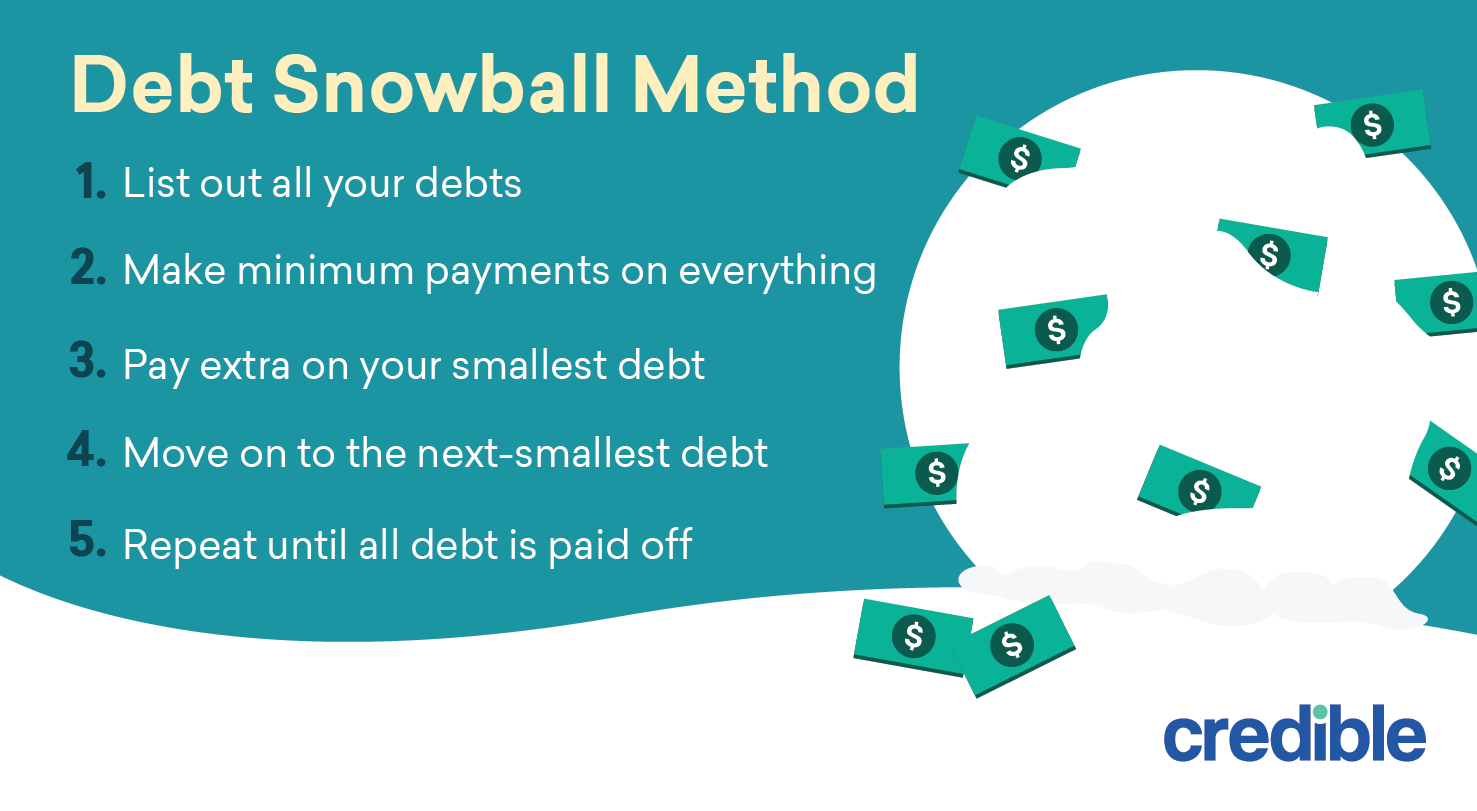
Pros
Faster results: You’ll likely see quicker results with the debt snowball method compared to the debt avalanche.Could help maintain motivation: Because you’ll be paying off balances sooner with the debt snowball, it could be easier to stay motivated.
Cons
Won’t save as much on interest: The debt snowball method generally doesn’t offer the same amount of interest savings as the debt avalanche.Could take longer: Because you won’t be saving much money on interest, it will likely take longer to fully repay your debt using the debt snowball method.
Check Out: Are Interest-Free Loans Really Interest-Free?
4. Reevaluate your current spending
Establishing a financial plan that prioritizes paying off debt could also help you tackle a $10,000 credit card balance. Here are a few strategies that could help:
Create (or update) your budget
Creating a budget is a good way to keep track of your income as well as your expenses. It can also help you plan for your financial goals — such as paying off your credit card debt.
To set up a budget focused on debt payoff:
Calculate your monthly income.Calculate your monthly expenses.Subtract your expenses from your income — this amount is what you can afford to put toward your debt.
Cut out the non-essentials
As you list out your monthly expenses, consider what you might be able to cut. For example, maybe you could unsubscribe from a streaming service you hardly use. Or you might start cooking at home to save money on dining out.
Tip: By reducing your spending, you’ll have more room in your budget to focus on paying off your credit card debt.
Sell your stuff
Many of us have unused items lying around the house that could be sold for extra cash. For example, you might consider selling electronics, furniture, or books.
Tip: If you don’t have anything to sell, you could consider purchasing items for cheap on a marketplace, upcycling them, and reselling for a profit.
Find a side hustle
After reviewing your budget, you might find that you don’t have much extra cash to put toward debt. In this case, you might think about starting a side hustle to earn more money.
For example, you could:
Drive for a ridesharing business, such as Uber or LyftDeliver food through DoorDash or UberEatsOffer freelance services, such as writing or consultingTutor local students
Frequently asked questions
Here are the answers to a few commonly asked questions about paying off credit card debt:
What is the monthly payment on a $10,000 loan?
The monthly payment on a $10,000 loan will depend on:
Interest rate: You’ll generally need good to excellent credit to qualify for the lowest available interest rates. The higher your interest rate, the more you’ll pay monthly as well as over the life of the loan.Repayment term: Personal loans typically come with a term ranging from one to seven years, depending on the lender. Choosing a longer term will likely get you a lower monthly payment — but it also means you’ll pay more in interest over time. It’s usually a good idea to choose the shortest term you can afford to keep your interest costs as low as possible.For example: Say you take out a $10,000 debt consolidation loan with a 10% interest rate and a five-year term. With these terms, you’d end up paying $323 a month with a total repayment cost of $11,616.
If you qualified for a 7% interest rate and chose a three-year term instead, you’d have a monthly payment of $309 and a total repayment cost of $11,115.
Is it smart to pay off one credit card with another?
You typically can’t use a credit card to make payments on another card. However, you can move your balance from one card to another with a balance transfer.
If you can qualify for a balance transfer card with a 0% APR introductory offer and can repay your balance before this period ends, then it could be a good way to save money on interest. But if you wouldn’t be able to pay off the card in time, you might be better off keeping your balances where they are.
How much credit card debt is OK to have?
Whether or not you have too much credit card debt depends on a couple of factors:
Monthly income: Having monthly debt payments that take up a large portion of your income can make debt unmanageable and saving for other goals impossible. It’s generally advised that monthly debt payments in total take up no more than 36% of your monthly income.Credit utilization: One of the major components of your credit score is your credit utilization ratio — the amount you owe on revolving credit lines (like credit cards) compared to your total credit limits. Using a high percentage of your available credit could have a negative impact on your credit. It’s typically a good idea to keep your credit utilization ratio under 30%.
If you decide to take out a personal loan to consolidate your credit card debt, remember to consider as many lenders as you can to find the right loan for you.
This is easy with Credible: You can compare your prequalified rates from multiple lenders in two minutes — without affecting your credit.
Ready to find your personal loan?
Credible makes it easy to find the right loan for you.
Free to use, no hidden feesOne simple form, easy to fill out and your info is protectedMore options, pick the loan option that best fits your personal needsHere for you. Our team is here to help you reach your financial goalsFind My Rate
Checking rates won’t affect your credit
Trustpilot
The post How to Pay Off $10,000 in Credit Card Debt appeared first on Credible.
Underwater Mortgage: What Is It and What Are Your Options?

Your home can be your biggest asset and a primary tool for building wealth over the long term. But like other assets you invest in, such as stocks and bonds, the value fluctuates. These fluctuations can put you underwater with your mortgage.
Here’s what you need to know about underwater mortgages and what you can do if you have one:
What is an underwater mortgage?Signs of an underwater mortgageProblems with underwater mortgagesUnderwater mortgage options
What is an underwater mortgage?
An underwater mortgage, also known as an upside-down mortgage or having negative home equity, is a home purchase loan with a principal balance that exceeds the value of the home — in other words, you owe the lender more than your home is worth.
Underwater mortgages were common during the Great Recession from 2007 to 2009, when home values throughout the country plummeted and continued to decline for several years after the recession’s end. Homeowners with purchase or refinance loans based on pre-crash home values found themselves underwater as a result.
Underwater mortgages are less common today because of tighter underwriting standards and record price increases since the pandemic. Median home prices increased nearly 25% from June 2020 to June 2021, so there’s a good chance that your home is worth more now than when you bought it.
Signs of an underwater mortgage
Situations that might push you into negative equity include a decrease in local property values. A low appraisal is also a good indicator that you might be underwater on your mortgage.
Here’s how to find out if your loan is underwater.
Figure out how much you owe
You can find out how much you owe by checking your mortgage statement. You’ll see the amount listed under “principal balance” or “outstanding principal”.
If you need to know the exact amount immediately, you’re best off calling your loan servicer and asking for your payoff amount. That figure will include interest and fees that have accrued since the lender prepared your statement.
Whether you’re researching rates or looking to buy a home, Credible is here to help. You can compare prequalified rates on home loans from all of our partner lenders in just a few minutes.
Credible makes getting a mortgage easy
Instant streamlined pre-approval: It only takes 3 minutes to see if you qualify for an instant streamlined pre-approval letter, without affecting your credit.We keep your data private: Compare rates from multiple lenders without your data being sold or getting spammed.A modern approach to mortgages: Complete your mortgage online with bank integrations and automatic updates. Talk to a loan officer only if you want to.Find Rates Now
Trustpilot
Determine your home’s value
The only way to get an accurate opinion of value is to have your home appraised by a licensed home appraiser. A professional home appraisal is usually worth the cost if you’re hoping to sell your home. Otherwise, you can get a ballpark figure for free from a real estate portal site like Redfin or Realtor.com.
Subtract your home value from your principal balance
The final step is a simple math problem that will show whether you’re underwater:
Value – Balance = Equity
If, for example, your home is worth $200,000 and you owe $225,000 on your mortgage, the equation will look like this:
$200,000 – $225,000 = -$25,000
In this scenario, you’re $25,000 underwater on your home loan.
Problems with underwater mortgages
An underwater mortgage doesn’t always have a negative impact on a homeowner. If your mortgage is affordable and you’re not planning to sell or refinance, you might not worry about it at all. However, when that’s not the case, an underwater mortgage can put you at a serious disadvantage.
Refinancing
Lenders protect themselves against default by limiting how much of your equity you can refinance. The limit might be 80% for a cash-out refinance, for example, or 95% for a rate-and-term refinance. But if you have negative equity, you have nothing to draw against.
Even in the event you find a loan that lets you refinance 100% of your home’s value, the new loan won’t fully repay the underwater one. In that case, you’ll have to pay enough cash at closing to make up the difference.
Also See: How to Refinance Your Mortgage in 6 Easy Steps
Selling
Most mortgage loans have a due-on-sale clause that makes the loan due in full when the owner sells. In the case of an underwater mortgage, where the sale won’t cover the amount needed to pay off the loan, you’ll need enough cash at closing to make up the difference.
Foreclosure
Your lender can’t foreclose simply because you’re underwater, but being underwater increases your risk of foreclosure because it limits your options. Since you might not be able to refinance or sell the home, there’s a greater chance of your home going into foreclosure if you can no longer keep up with the mortgage payments.
Underwater mortgage options
You don’t necessarily have to take action when your mortgage is underwater, but it’s probably a good idea, even if only to ward off future problems. If you’re already struggling, a quick response can keep you from losing your home.
Stay in your home
The simplest option is to remain in your home and continue making your regular mortgage payments. By paying down your principal balance, you’ll continue to build equity. Consider making extra principal payments to pay down your loan balance faster.
You can also try to increase the value of your home. Home remodeling projects rarely generate a positive return on investment unless you can do the work yourself, but simple jobs that improve curb appeal can give your home value a boost for little cost beyond elbow grease.
Tip: If you can’t afford to make extra principal payments or remodel your home, sit tight and wait for a market cycle more favorable to sellers. This can right your mortgage naturally as values appreciate.
Refinance
Refinancing an underwater mortgage is tricky because you typically need equity to do it. However, you might be in luck if your loan is backed by Freddie Mac.
The Freddie Mac Enhanced Relief Refinance is meant for homeowners whose mortgages are underwater. This option could make your loan more affordable by lowering your mortgage rate and monthly payment or allow you to increase your equity faster with a shorter repayment period.
The program is available if you took out your home loan on or after Oct. 1, 2017, and are current with payments. Additional requirements include having had no 30-day delinquencies within the last six months and no more than one 30-day delinquency in the last year. Fannie Mae has a similar program but has paused it temporarily.
What about government-backed loans? Certain government-backed loans may still allow you to refinance if your mortgage is underwater. The FHA streamline refinance program, for instance, doesn’t require an appraisal, so you can refinance your FHA loan even if you have negative equity.
On the other hand, the VA no longer guarantees loans where the loan-to-value ratio exceeds 100%. Some lenders do set a higher cap on streamline refinances, but the cap includes closing costs and funding fees that the lender rolls into the loan. These costs can put you even further into negative equity.
Sell your home
You’ll have to meet one of two conditions to sell a home with an underwater mortgage:
Make up the difference between your loan balance and the sale price with a cash payment at closingGet permission from your lender to sell short
Unless you’re struggling to make payments, in which case you probably lack the funds to bring cash to closing, it doesn’t make sense to sell while your mortgage is underwater. But if you are struggling, a short sale can be an alternative to foreclosure.
Your lender won’t allow a short sale unless you document a hardship that’s likely to keep you from making payments for the foreseeable future, such as a job loss or disability. It can also take months before your lender approves the short sale.
In the meantime, you might rack up enough late payments that a short sale will do as much harm to your credit as a foreclosure would. And if the lender does approve the short sale, you might have to pay tax on the amount of the loan balance the lender forgives.
Walk away
Your last resort is to simply walk away from your home and let the lender foreclose on it. This option is called a strategic default because you’ll have concluded that you’re unable to stay in the home and instead plan to use the money to pay off other debt or build savings for rent.
Foreclosure will negatively impact your credit and remain on your credit report for seven years. As such, you might find it difficult to rent a home. Paying some or all of your rent upfront, though, gives you a better chance at having your rental application approved.
Important: One more option you can try before walking away is a loan modification. This is an agreement between you and your lender that changes the terms of your loan and makes your mortgage payment more affordable. Your credit might still take a hit, but it can at least help you avoid foreclosure. Talk to your lender to see if you qualify.
The post Underwater Mortgage: What Is It and What Are Your Options? appeared first on Credible.
Did you miss our previous article…
https://www.coloradomicrofinance.org/?p=235
16 Fast Weekend Projects to Boost Your Home’s Curb Appeal
Taking on projects to boost your home’s curb appeal can give you a great sense of satisfaction and boost your mood every time you see your completed work.
Here are 16 projects that aren’t expensive or time-consuming — and that you can often do yourself:
Sweep the front porchGet a new front porch matHang a decorative wreathAdd potted plants to your front porchHide your hoseEliminate weedsAdd natural mulchReplace light fixturesClean, touch up, or completely repaint your front doorClean and polish or change front door hardwarePrune flowers and shrubsPressure wash your concreteHire a tree trimmerEmbellish your garage doorStyle your mailboxAttach house numbers

1. Sweep the front porch
The fastest, cheapest thing you can do to boost your home’s curb appeal is to get out a broom and dustpan and sweep your front porch.
You’ve probably become oblivious to the dead leaves and dirt that have accumulated there, so cleaning up will make an instant difference. Everyone who walks up to your front door is sure to notice.

2. Get a new front porch mat
Now that you’ve got a clean front porch, the next simplest way to spruce it up is with a new porch mat. Chances are, you either don’t have one at all, or you have an old one that’s looking ratty.
Hit up a big box store for a simple mat or outdoor rug you can use year-round. Buy a seasonally themed mat from virtually any home goods vendor. Or order something customized from a creator on Etsy.
If you need cash for a major home improvement project, consider a cash-out refinance. Credible can help you find a great refinance rate from our partner lenders in just a few minutes — checking rates with us is free, secure, and won’t affect your credit score.
Get the cash you need and the rate you deserve
Compare lendersGet cash out to pay for home improvementsPrequalify in just 3 minutesFind My Loan
No annoying calls or emails from lenders!
Trustpilot

3. Hang a decorative wreath
If you want to dress up your front door, try a wreath! You don’t have to hammer a nail into the door to hang it, either. You can use a temporary adhesive hook or an over-the-door hanger.
Choose from holiday-specific wreaths (like Halloween or Easter), seasonal wreaths to celebrate fall or spring, or year-round wreaths that look good all the time.
Front door signs, hung on the door or propped next to it, are also a simple and affordable way to make your front entrance more inviting.
Don’t Miss: 8 Popular Pandemic Home Renovations to Transform Your Space

4. Add potted plants to your front porch
Even the smallest front porch usually has room for a potted plant or two. You might go for a vibrant magenta Tradescantia zebrina or a classic green fern. Consider how much sun the plants will get: You might need shade-loving varieties. Also, keep pet safety in mind.
If you purchase plants from your local nursery, you’re almost guaranteed to get something that’s well-suited to the season and climate, but for a wider selection, you can order plants online.
Tip: If your gardening skills are nonexistent, consider a high-quality artificial plant. You might be surprised by how realistic they can look!

5. Hide your hose
Many of us have a hose in front of our house that we don’t put away because we use it so often. As convenient as this is, some form of hose storage will eliminate the visual clutter of an uncoiled hose.
If you have the right power tools, you can mount a hose holder to a wall, but if you don’t want to drill holes into your home — or you’re looking for an easier project — a hose pot will also work.
One free, temporary fix is to just unscrew your hose from the faucet and store it in the garage. This can be a good option if you just want to impress guests in the short term and aren’t looking for a long-term solution.

6. Eliminate weeds
Weeds are another nuisance that you might have stopped noticing if you see them day after day. Pulling them can be a ton of work, and it won’t work long-term unless you get all the roots out.
There are, however, natural ways to kill weeds using substances you already have around the house. Vinegar, salt, and dish soap can help you kill unwanted plants. Check online for DIY recipes and application tips.
For weeds in your lawn, adjusting your watering and mowing patterns can also help limit weed growth going forward.

7. Add natural mulch
In flower beds and gardens, a thick layer of mulch will help prevent those weeds you just pulled from growing back. Mulch’s sunlight-blocking power also retains soil moisture so you can water less and keep your plants healthy.
You’ll want to do a bit of research to determine the best kind of mulch for your plants and climate, how close to your trees and plants it can be, and which types of mulch are the safest for people and pets.

8. Replace light fixtures
Replacing your old exterior light fixtures with more modern ones can help update your home’s look. It involves some electrical work, so you may want to hire an electrician. However, if you’re comfortable learning basic electrical safety, reading instructions, and watching a few videos, replacing light fixtures can be an easy DIY job.
For an extra-fun change, use smart light bulbs in your new fixtures. You can control these via WiFi and change their color and brightness with your smartphone.

9. Clean, touch up, or completely repaint your front door
Your front door will get dirty and fade over time since it’s exposed to the elements 24/7. Sometimes, just cleaning it with a wet rag will make a big difference, but other times, your door will need a paint job to look its best.
Painting your front door a bright color that complements the other colors in your home’s exterior can make your home stand out in a good way — and potentially raise your home’s value.
The ideal way to do the job will involve removing the door and hardware, filling and sanding any cracks, painting, then reinstalling the door. But you can also paint it in place by taping off the hardware and putting down a drop cloth to prevent paint drips and spills from marring your porch.

10. Clean and polish or change front door hardware
So many things in our homes can look like they need replacement because we’ve never cleaned them properly, and door hardware definitely falls into that category. The solution is sometimes as simple as a dish soap and water mixture.
For problems that go beyond surface dirt, you’ll need to know what material the doorknob is made of. Coated or plated hardware can require different cleaning approaches than solid metal. If your door hardware has corroded due to factors like humidity or salt air, replacing it is probably the best.
Keep Reading: 10 Ways to Craft an Elegant Outdoor Space

11. Prune flowers and shrubs
You should be able to improve your curb appeal by pruning away the dead parts of your flowers, shrubs, and hedges. If you can reshape them, even better!
You might also need to pull out plants that are beyond recovery and add new ones. Planting new flowers in full bloom is a great way to quickly add color to your landscape.

12. Pressure wash your concrete
To get stains and mildew out of the hard surfaces around your home, like your patio and driveway, try pressure washing. With the right detergents and degreasers, you can remove years of grime. Best of all, it’s one of those home improvement projects you can wrap up in a day.
You can borrow a pressure washer from a neighbor or rent one from a home improvement store. Carefully follow the instructions so you don’t hurt yourself. Also, certain materials can be damaged by pressure washing, so do your research first, or hire a professional.

13. Hire a tree trimmer
Having your trees professionally trimmed can make a big difference in your curb appeal.
An arborist will know how to shape your trees to make them look their best. They can also keep your trees healthy by thinning enough branches to improve air circulation and treating any problems that might be weakening your trees.
Besides, it’s a good idea to identify trees or limbs that could be in danger of falling in a storm, then take care of them promptly. A house that’s been partially crushed by a tree is not a pretty sight.

14. Embellish your garage door
If you have a traditional raised-panel garage door, you can add decorative or “dummy” hardware to make it more attractive. These handles and hinges don’t serve any functional purpose, but do add visual interest. There are also kits that allow you to add simulated windows.
Give your door a carriage style, mid-century modern, or contemporary look to go with the rest of your home. Just make sure to install the embellishments in a way that won’t affect the door’s ability to open and close smoothly.

15. Style your mailbox
A professional might be able to build you a custom stone mailbox in a weekend, but for a more affordable DIY upgrade, you have a few options.
If you have a metal mailbox, try cleaning it and spray painting it. You can also order decals, letters, and numbers to customize your mailbox. Or perhaps landscape your mailbox by adding plants and flowers around it.
Keep in mind that you’ll need to prune them periodically, and you may not want to plant anything that attracts lots of bees (like lavender) so you don’t have to worry about getting stung when you check the mail.

16. Attach house numbers
You can make sure your address is prominently displayed on your house by replacing old house numbers or installing new ones. This is also a way to ensure that emergency services can locate your home and that someone else’s packages don’t get dropped on your doorstep. Kits are available online in all different styles.
Boosting your curb appeal is a great way to get more money when selling your home. But even if you’re not selling, sprucing up your home’s exterior will increase your pride of ownership and create a more welcoming experience for your guests. And once you see the results of your first project, you’ll probably feel inspired to do even more.
Shopping around for a home loan can be stressful. Fortunately, Credible simplifies this process and makes comparing multiple lenders easy. You can see prequalified refinance rates from our partner lenders in just a few minutes.
window.credibleAsyncInit = function() {
CredibleSDK.initWidget(‘#credible-rate-table’, {
environment: ‘production’,
product: {
marketplace: ‘mortgage-combined’,
type: ‘rate-table’,
variation: ‘shortened’,
loantype: ‘refinance’,
},
analytics: {
source: ‘credible_blog’,
},
});
CredibleSDK.initWidget(‘#mortgage-combined-rate-widget-simple’, {
environment: ‘production’,
product: {
marketplace: ‘mortgage-combined’,
type: ‘rate-widget’,
variation: ‘simple’,
},
analytics: {
source: ‘credible_blog’,>
The post 16 Fast Weekend Projects to Boost Your Home’s Curb Appeal appeared first on Credible.
Did you miss our previous article…
https://www.coloradomicrofinance.org/?p=219




